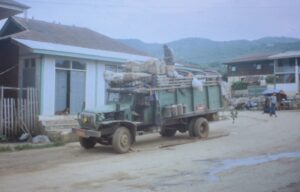May 12, 2005
We’ve crossed the border into Malaysia, one of my favorite countries in Asia, and into one of my favorite cities, Penang. When I say it’s all karma, I can use as an example getting to Penang. Eight years ago, my son and I were on a train from Bangkok to Singapore when our fellow travelers told us to stop at Penang. After consulting the Lonely Planet guide book, we broke our journey and spent a full day exploring the city, which has wonderful colonial architecture, great history (almost 200 years of it–the British valued it as a naval base to control the Straits of Malacca, and named it for the Malay word for betel nuts, which used to grow in abundance), and wonderful food. We had such a neat time here, that I brought Mrs. Hoyt here four years ago, and wanted to share the city with my students this year.
We have been busy all day–tour of the city, a visit to the Dell Asia plant (if you have a notebook, it was made here), and some wondrous food. Malaysia is 28 million people, about 60% Muslim, 38% Chinese and 12 % Indian, reflecting (do not check my math) the makeup of the colonial country. Our guide, an Indian, had a grandparent who came to stoke fires in the rubber plantations. What that means is great diversity, and wonderful food. The hotel we are at serves roti for breakfast, and we had tandoor chicken for lunch. This evening we went to a hawker court, which was full of food stands, having satay and the variety of foods that are Chinese, Indian, and Malay. Does not get much better than that.
Alas, at 6 am, we are on our way to Kuala Lumpur, or as it is known out here, KL.









 and the barometer was 26″).
and the barometer was 26″).
 bringing cabbage to the truck taking it to Mandalay.
bringing cabbage to the truck taking it to Mandalay. from 2 p.m. to 7 a.m.—and she was lucky because she knew when they’d stop power on her. Our power went off periodically. Phone to the US (when available) is $8 a minute; email is censored and we could not get our titan account. Imagine trying to do business under these conditions.
from 2 p.m. to 7 a.m.—and she was lucky because she knew when they’d stop power on her. Our power went off periodically. Phone to the US (when available) is $8 a minute; email is censored and we could not get our titan account. Imagine trying to do business under these conditions. uddhism here is very different than the Chinese/East Asian style.
uddhism here is very different than the Chinese/East Asian style.
